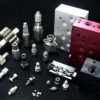A new test for silicosis shows serious promise in an early study and is now undergoing analysis in larger cohorts.
Scientists at the UNSW Sydney are developing a new diagnostic tool that reads a person’s breath for signs of silicosis, and it also has the potential to find the disease earlier instead of waiting for irreversible lung damage to appear.
Silicosis is a lung disease caused by prolonged inhalation of crystalline silica dust, commonly found in mining, and manufacturing industries.
When inhaled, silica particles become embedded in lung tissue, leading to inflammation, scarring, and reduced lung function. Over time, this condition can cause symptoms such as chronic cough, shortness of breath, and chest pain.
There are three types: chronic, accelerated, and acute, depending on the duration and intensity of exposure. Silicosis is irreversible and can increase the risk of tuberculosis and lung cancer. Preventative measures include protective equipment, proper ventilation, and minimizing dust exposure in high-risk workplaces.
In a study published today in the Journal of Breath Research, Professor William Alexander Donald and Conjoint Professor Deborah Yates describe a rapid, AI-powered breath test that could transform silicosis diagnosis.
The test combines mass spectrometry, a scientific technique for analyzing molecules, with AI to quickly detect silicosis from breath samples. It offers a fast and non-invasive diagnostic tool for at-risk workers.
Silicosis, a lung disease caused by inhaling crystalline particles of silicon dioxide, poses a major occupational health concern in Australia. The disease has spread beyond engineered stone workers to those in tunnelling and construction.
Read more: Breath Diagnostics pioneers novel lung cancer breath test
Read more: Breath Diagnostics takes aim at lung cancer with One Breath
New test provides results within minutes
The Australian government has banned engineered stone, but new cases continue to emerge from other high-risk industries, highlighting the urgent need for better diagnostic tools. Unlike traditional methods such as CT scans, which detect silicosis in later stages, the test provides results within minutes.
“Our study shows that the AI-driven model accurately distinguished silicosis patients from healthy individuals based on their breath profiles, providing a reliable tool for early detection, ” said Professor Donald, the lead researcher from UNSW’s School of Chemistry.
“This suggests that breath testing could be a practical tool for large-scale worker screening and early intervention.”
The study analyzed breath samples from 31 silicosis patients and 60 healthy controls. It confirmed the test’s ability to differentiate between affected and unaffected individuals with high accuracy.
To test for silicosis using the new technology, participants breathe into a bag. The system then pushes the breath content to a mass spectrometer, which detects all the different molecules present.
“In human breath, there are thousands of organic molecules that you breathe out,” Prof. Donald says.
“Our instrument can make a profile of the someone’s breath, and then we feed that into an artificial intelligence algorithm that’s really good at finding pattern.”
The researchers emphasize that while the breath test shows great promise, they need to validate it further in larger cohorts before implementing it as a routine screening tool.
Read more: Breath Diagnostics onboards new president and closes critical financing
Read more: Focus on diet for lung cancer prevention isn’t strong enough, research shows
Breath composition varies depending on collection method
The notion of using the composition of the breath to diagnose certain diseases is not limited to issues like silicosis.
A Kentucky-based startup called Breath Diagnostics has developed a technology which detects cancer using biomarkers taken from a single breath.
Breath composition varies significantly depending on the method of collection, introducing inconsistencies in biomarker concentration measurements.
Traditional sampling techniques differentiate between end-tidal breath, which captures deep lung air; late expiratory breath, which includes upper airway contributions; and mixed breath, which blends lung and oral cavity air.
These variations make it challenging to establish reliable diagnostic thresholds, as different sampling methods yield different biomarker concentrations.
Breath biomarkers exist in extremely low concentrations. Traditional methods rely on sorbent tubes, such as thermal desorption tubes, solid-phase microextraction (SPME), and needle trap devices (NTDs). However, these approaches introduce contamination risks and sample degradation, leading to inconsistent and unreliable results.
Additionally, the need for improved pre-concentration methods remains a critical challenge in breath analysis.
Furthermore, gas chromatography-mass spectrometry (GC-MS) is widely see as the gold standard for breath biomarker validation, yet it presents several inefficiencies.
The heating process required for desorption poses a risk of thermal degradation, while the transfer of volatile organic compounds (VOCs) often results in sample loss. Additionally, ionization efficiency is inconsistent, further complicating analysis.
The most significant limitation is the time required. GC-MS can take up to an hour per sample, making it impractical for routine diagnostic use. These drawbacks have slow the widespread adoption of breath analysis.
Read more: Sweet potato extract inhibits lung cancer growth, Tennessee researchers discover
Read more: University of Hong Kong new AI program helps improve cancer diagnosis accuracy
OneBreath eliminates variability in collection methods
OneBreath also standardizes breath sampling by needing a single exhale into a polyvinyl fluoride called Tedlar bag. These bags are specifically designed to pick up volatile organic compound (VOC) concentrations.
This approach eliminates variability in collection methods, leading to more precise biomarker concentration measurements and improved reproducibility in clinical applications.
The technology incorporates a novel microreactor for VOC capture. It replaces traditional adsorption-based trapping methods that rely on heating to release samples.
Instead of physically adsorbing VOCs, the microreactor chemically derivatizes them into stable cationic adducts. This process prevents sample loss, reduces contamination risks, and enhances measurement sensitivity.
For analysis, OneBreath employs a method that improves ionization efficiency. Unlike GC-MS, which requires thermal desorption and can result in sample degradation, OneBreath uses cold solvent rinsing to release VOCs. This eliminates the risk of thermal fragmentation and allows for more accurate and sensitive mass spectrometry analysis.
OneBreath utilizes Ultra High Performance Liquid Chromatography Mass Spectrometry (UHPLC-MS) for biomarker detection, eliminating the need for thermal desorption. This approach prevents sample degradation, removes the requirement for complex desorption steps. Further, it ensures consistent and efficient ionization by keeping all adducts in a positively charged state.
The system is designed for high throughput analysis, addressing the inefficiencies of traditional breath analysis methods. GC-MS can take over an hour per sample. In contrast, OneBreath reduces UHPLC-MS analysis time to under 10 minutes per sample, while patient sampling takes only 30 seconds. This increase in efficiency makes breath biomarker testing commercially viable at scale, enabling broader clinical adoption.
.
Follow Joseph Morton on Twitter
joseph@mugglehead.com













